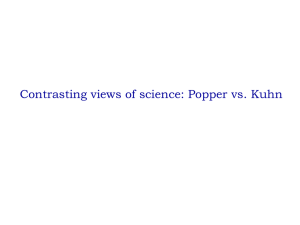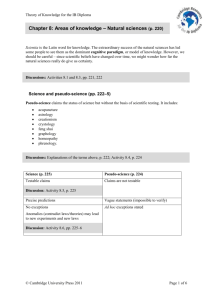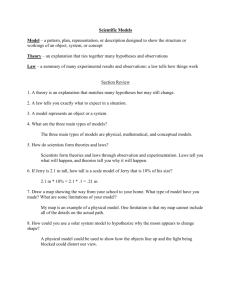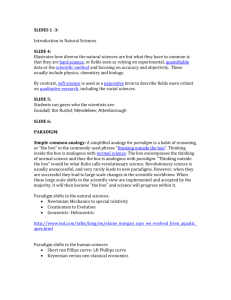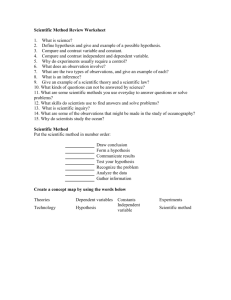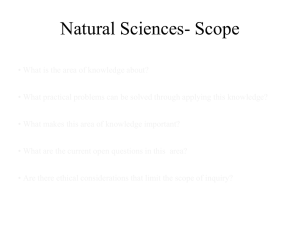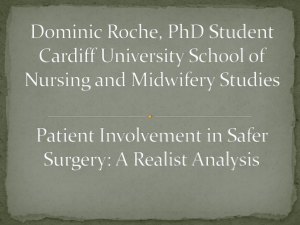Sociology and Science
advertisement
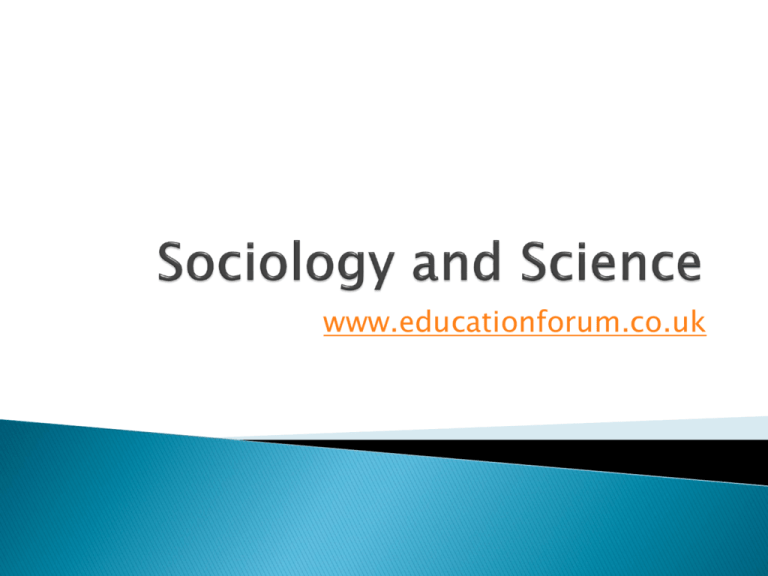
www.educationforum.co.uk Many scientists claim there is a clear distinction between science and the supernatural. A good recent example is Richard Dawkins who in ‘The God Delusion’ 2006 makes the following observations about science and religion; ‘Fundamentalists know they are right because they have read the truth in a Holy Book.... the truth of the Holy Book is an axiom, not the end product of a process of reasoning. The book is true and if the evidence seems to contradict it, it is the evidence which must be thrown out, not the book. By contrast, what I as a scientist believe, I believe not because of reading a Holy Book but because I have studied the evidence..... When a science book is wrong somebody eventually discovers the mistake and it is corrected in subsequent books. That conspicuously does not happen with Holy books’ According to Dawkins then science is characterised by; 1. Objectivity – the scientist is neutral 2. Scientific enquiry is evidence based – conclusions are based on evidence not preconceived ideas 3. Scientific enquiry is ‘open’ – ideas which are tested and ‘falsified’ are rejected and more accurate ones replace them. Michael Lynch (1983) asserted that science is far less objective than scientists claim. Lynch studied scientists experimenting on lab rats and concluded that the scientists were far more influenced by their existing theories than other may have thought. Specifically when ‘anomalies’ occurred i.e. results they were not expecting, they were put down to unnamed errors in the production of photographs they were studying rather than as evidence towards a new theory or hypothesis. Positivists like Comte believed that sociology is scientific. It is about gathering information about the social world, classifying data and drawing conclusions that uncover ‘the social laws’ which govern human society. Durkheim took this position a little further by claiming that by using his technique of multivariate analysis ‘social facts’ can be uncovered. Multivariate analysis is the attempt to isolate the impact of independent variables (the causes of something), on the dependent variable (the something which has been caused). For instance working class underachievement in school might be seen as the dependent variable and material deprivation, and teacher labelling the independent variables. Durkheim believed that by complex in depth statistical analysis the independent variables could be measured and a social law established. The early positivists used an inductive approach. This means data was first collected, studied, analysed and then a theory or hypothesis composed. The hypothesis is then tested and conclusions drawn. If it was repeatable (reliable), the hypothesis became a social fact. The deductive approach is similar the inductive approach only in reverse. Popper stressed that theories or hypotheses could spring from anywhere such as flashes of inspiration (eureka moments) or even from dreams. What is crucial however is how hypotheses are tested. This must occur rigorously and scientifically. Popper rejected the idea that there are permanent social laws governing human behaviour claiming that any ‘law’ could at some point be falsified no matter how many times it has been proved correct in the past. The famous example he gave was the hypothesis ‘all swans are white’ which can be proved thousands of time until you encounter a black swan. Popper said the aim of science and social science should be to constantly strive to falsify theories. This point arguably distinguishes science from religion and supernatural belief systems. Roger Gomm suggests that most scientists and social scientists try to prove rather than falsify theories and that their ideas should be viewed in the social context from which they emerged. Gomm cited the example of Darwin and his theory of evolution to explain his position. Gomm suggests that Darwin’s theories of natural selection and the competitive struggle for the survival of the fittest were not supported by all of the evidence. Darwin therefore missed the opportunity to ‘falsify’ aspects of his theories. Gomm suggests the reason for this was ideological rather than scientific. The survival of the fittest theory fitted neatly into Victorian capitalist ideology of free market capitalist economics, individualism and a minimalist approach to welfare of the time. Gomm therefore emphasises the importance of placing ‘science’ in its social context. Scientific knowledge can be in part seen as socially constructed. Thomas Kuhn challenges the idea that science is objective Kuhn in ‘The structure of Scientific Revolutions’ introduces the idea of scientists at certain times in history working in a paradigm. A paradigm as used by Kuhn refers to the framework of accepted ideas in which they operate. A paradigm might include ideas on truth, validity and methodology. Kuhn argues that scientist will tend to work within the paradigm and thus seek evidence which supports the paradigm until such time as anomalies are so strong as to precipitate a paradigm shift or revolution. A new ‘normal science paradigm’ is established and the process begins again. Q1. According to Dawkins what distinguishes science from religion? Q2. What is the difference between an inductive and a deductive scientific approach? Q3. What is meant by falsification and why is it viewed as important to the scientific process? Prefer methods similar to those used in the natural sciences Surveys, cross-sectional surveys, longitudinal studies, experiments, field experiments, case studies Using your A2 books and last years notes make sure you are able to describe and evaluate each of these methods Positivist methodology uses processes to ensure representativeness. If the sample surveyed is representative of the wider whole it is possible to generalise the conclusions. Representativeness is established through sampling techniques. Revise the following sampling techniques: random (systematic and stratified), cluster, quota, snowball. Assess the view that positivistic methods are inappropriate for understanding society (40 marks)


